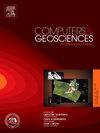PyInvGeo: An open-source Python package for regularized linear inversion in geophysics
IF 4.4
2区 地球科学
Q1 COMPUTER SCIENCE, INTERDISCIPLINARY APPLICATIONS
引用次数: 0
Abstract
We developed several algorithms to solve the generalized linear inversion problem. In real-world problems, the datasets are huge and direct inversion of data matrix is not possible. Iterative algorithms can provide the desired solution by iteratively updating the solution along the opposite direction of the gradient. Hence, we develop steepest descent with , Huber, Cauchy, and hybrid norms regularization, conjugate gradient with smoothness and sparsity constraints, FISTA, and alternating minimization algorithms. L-curve for the minimization and Generalized Cross Validation function for the minimization are used to provide the optimum regularization parameter. The numerical seismic deconvolution tests on synthetic single-channel data show the performances of the different algorithms and the parameter selections. Then, based on the performances of the algorithms on single channel data, we select the conjugate gradient with sparsity constraint and FISTA for deconvolution of Teapot dome 2D real data. We find that on 2D data, the FISTA method provides sparser solutions. However, through deconvolution of 3D seismic data, by increasing the dimensions and complexity of signals of interest, we show that the FISTA algorithm struggles to provide continuous and interpretable results. To address this issue, we introduce the Hoyer-squared norm to promote sparsity. Hoyer-squared norm is almost everywhere differentiable, scale-invariant, and contrary to norm it does not equally shrink all the coefficients. The 3D deconvolution shows that the Hoyer-squared method outperforms FISTA and provides a continuous and interpretable solution. Finally, we develop a Hoyer-squared-based multiple suppression in the Radon domain and successfully test the algorithm on synthetic and real marine Gulf of Mexico data. The multiple suppression algorithm is based on the parabolic Radon transform. The Python package for the algorithms and numerical testes is included for reproducibility purposes and to facilitate the use of the algorithms on different problems.
PyInvGeo:一个用于地球物理学正则化线性反演的开源Python包
我们开发了几种算法来解决广义线性反演问题。在现实问题中,数据集是巨大的,数据矩阵的直接反演是不可能的。迭代算法可以通过沿着梯度的相反方向迭代更新解来提供所需的解。因此,我们发展了最陡下降,Huber, Cauchy,和混合1/ 2规范正则化,光滑和稀疏约束的共轭梯度,FISTA和交替最小化算法。利用l -曲线和广义交叉验证函数给出了最优正则化参数。通过对合成单通道数据的地震反褶积数值实验,验证了不同算法的性能和参数选择。然后,基于算法在单通道数据上的性能,我们选择了带稀疏约束的共轭梯度和FISTA对Teapot dome二维真实数据进行反卷积。我们发现,在二维数据上,FISTA方法提供了更稀疏的解。然而,通过对三维地震数据进行反褶积,通过增加感兴趣的信号的维数和复杂性,我们发现FISTA算法难以提供连续和可解释的结果。为了解决这个问题,我们引入了霍耶平方范数来提高稀疏性。霍耶平方范数几乎处处可微,比例不变,与1范数相反,它不会相等地收缩所有系数。三维反褶积表明,Hoyer-squared方法优于FISTA方法,并提供了连续和可解释的解决方案。最后,我们开发了一种基于hoyer平方的Radon域多重抑制算法,并成功地在合成和真实的墨西哥湾海洋数据上进行了测试。多重抑制算法基于抛物线Radon变换。包含用于算法和数值测试的Python包是为了再现性目的,并便于在不同问题上使用算法。
本文章由计算机程序翻译,如有差异,请以英文原文为准。
求助全文
约1分钟内获得全文
求助全文
来源期刊

Computers & Geosciences
地学-地球科学综合
CiteScore
9.30
自引率
6.80%
发文量
164
审稿时长
3.4 months
期刊介绍:
Computers & Geosciences publishes high impact, original research at the interface between Computer Sciences and Geosciences. Publications should apply modern computer science paradigms, whether computational or informatics-based, to address problems in the geosciences.
 求助内容:
求助内容: 应助结果提醒方式:
应助结果提醒方式:


